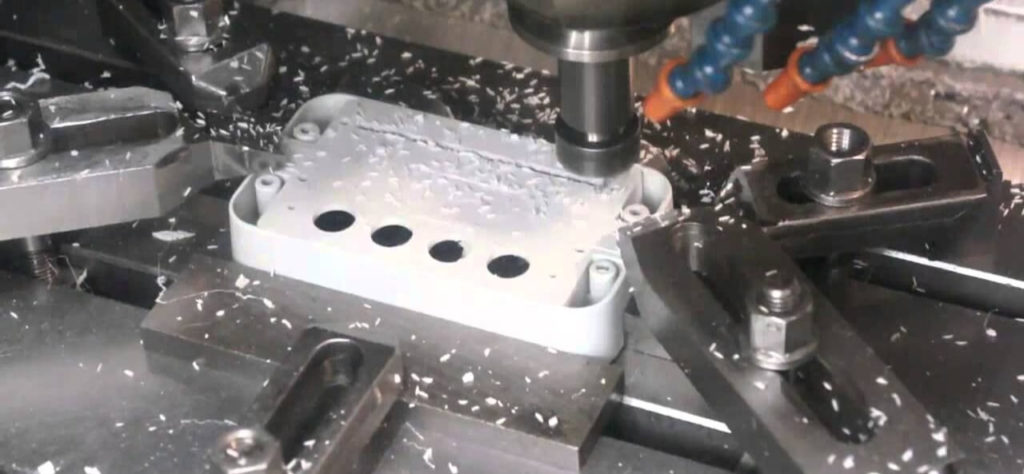Machining center is a comprehensive equipment with milling machine, boring machine, drilling machine and other functions. It has high production efficiency. CNC milling machine generally does not need to use special process equipment such as special fixtures. It is enough to clamp the tool and adjust the tool data, thus greatly shortening the production cycle. In addition, the spindle speed and feed speed of the machining center are infinitely variable, so it is beneficial to choose the best cutting amount, which can complete face milling, shoulder milling, copy milling, cavity milling, slot milling, turning milling, Thread milling, plunge milling, ramping milling and circular interpolation milling, etc. The following briefly introduces the process characteristics of the machining center:
1. Selection Of Milling Direction Of Machining Center
During milling operations, the workpiece can be fed in or relative to the direction of tool rotation, which affects the start and finish characteristics of the cut. Climb milling is the preferred method regardless of the machine, fixture and workpiece requirements. However, if the tool is pushed into the workpiece, the feed will increase irregularly, resulting in excessive cutting thickness and causing chipping, and up-cut milling should be selected in such applications. In addition, when the machining allowance changes greatly, it is more advantageous to choose up-cut milling.
2. Diameter And Position Of Milling Tool
The choice of milling cutter diameter is usually based on the width of the workpiece and the available power of the machine. Especially in face milling, the milling width of the workpiece will directly determine the diameter of the milling cutter. The cutter diameter should normally be larger than the workpiece width, as this helps ensure good chip formation and proper cutting edge loading. Ideally, the milling cutter should always be positioned slightly off-centre, as the kerf formed by each insert is very small, and the entry and exit of the inserts facilitate chip formation and prevent shock loads. But if the tool is fully centered, as the cutting edge enters or exits the kerf, the radial force of even magnitude changes in direction, the machine spindle vibrates, and the insert may break, resulting in a poor surface quality . The position of the cutter relative to the workpiece, the passes and the contact with the teeth are all extremely important factors in the successful completion of the operation.

3. Cutting Tool Entry And Exit Conditions
Every time a milling cutter insert enters the kerf, the cutting edge may experience shock loads. This depends on the chip cross section, workpiece material and chip type. Of great importance to the milling process is the appropriate type of initial and final contact between the cutting edge and the workpiece material. In addition, accurate positioning of the tool is also important for the entry and exit of the cutting edge.
(1) The width of the workpiece is greater than or equal to the diameter of the milling cutter
In this case, the tool centerline is completely outside the width of the workpiece, and the outermost tip of the insert is strongly impacted as it plunges. This means that the most sensitive parts of the tool are susceptible to the initial shock load. The insert also leaves the kerf with only tip contact, which means that the cutting force is fully applied to the outermost end of the insert and held until the insert abruptly disengages from the workpiece. This is the shock unloading force.
(2) The diameter of the milling cutter is slightly larger than the width of the workpiece
In this case, the centerline of the tool is aligned with the edge of the workpiece. When the chip thickness is at its maximum, the insert leaves the kerf and the impact load is very high as the insert cuts in and out.
4. The Choice Of Cutting Oil
In most cases, the milling process of the machining center has the characteristics of ultra-precision, small batch, and complex process. Therefore, when selecting cutting oil, special machining center cutting oil should be selected. The special cutting oil for machining center has excellent extreme pressure and anti-wear performance, which can effectively improve the machining accuracy. And it has good versatility and is suitable for various complex processes in machining centers. Compared with non-specialized rapeseed oil, mechanical oil, and regenerated oil, it can greatly extend the service life of tools and equipment, avoid problems such as rusting and yellowing of the machine, and reduce the overall production cost of the enterprise.
The above are the problems that need to be paid attention to in the machining center milling process. Reasonable arrangement of the process steps will help improve production efficiency.


